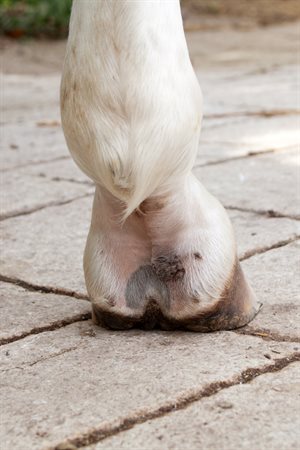
This article has appeared previously with Equestrian Life. To see what's in our latest digital issue, click here.
Greasy heel and mud fever are a couple of the more common terms for what could more accurately be described as “pastern dermatitis”.
QUESTION: My horse has greasy heel and isn’t living in a damp or humid environment. How can I treat and prevent this, and could you tell me more about greasy heel/mud fever?
BY DR MAXINE BRAIN
ANSWER: GREASY HEEL and mud fever are a couple of the more common terms for what could more accurately be described as “pastern dermatitis”. The dermatitis usually involves the hind aspect of the pastern, although it can spread to involve the entire pastern and sometimes the entire lower limb. It is a headache for most owners to treat as often the inciting cause is not obvious, and the secondary involvement of bacteria and fungi overwhelms the clinical picture.
Terms like “mud fever” are used because the wet and damp environment causes softening of the skin, and this, together with the tendency of mud and dirt to damage this skin, allows micro-organisms to infiltrate the area and set up a localised infection. Exudate then oozes through the skin as a result of the inflammation, causing the hair to mat and scabs to form, trapping more exudate in the hair. This exudate is irritating to the skin and causes further inflammation to the tissues, which results in a vicious cycle of inflammation, exudate, irritation, more inflammation, more exudate and more irritation.
There are other initiating causes that can affect the sensitive skin at the back of the pastern and allow for dermatitis to occur, hence why your horse may have greasy-heel when he is not in a wet environment.
Other known causes of pastern dermatitis include various bacteria, some fungi, mites, photosensitisation, contact hypersensitivity, irritants, pastern or hoof gear, and some immune-mediated diseases. Any of these conditions can cause the initial inflammation, which can be complicated by the involvement of secondary organisms. These secondary organisms contribute to the clinical symptoms, often overwhelming the original source of the problem. By the time the horse is seen by the vet, the inciting cause is long gone, or totally unidentifiable, and the bulk of the treatment is aimed at controlling the secondary offenders. It is fine to treat the secondary pathogens, as long as the initiating cause has resolved, but if not, the underlying issue will continue to cause inflammation and therefore further problems until it is eliminated or managed appropriately.
As there are numerous causes of pastern dermatitis, there are also numerous treatments on the market that are promoted as “cures” for it. There is no one treatment that fixes all. Adding to the dilemma is the tendency for owners to over-treat the dermatitis in a desperate attempt to cure it. This results in an over-sensitised, inflamed heel that nothing seems to resolve.
Identifying the original cause of the dermatitis can be very difficult, unless it is something obvious like a wet muddy environment or a known irritant that has been applied to the pasterns. If it is only the white areas of the horse that are affected then photosensitisation may be the underlying cause. The skin should be examined for evidence of mites, particularly in breeds that have a lot of feathering on their lower limbs. A thorough review of the history of the horse, including what paddocks it has been in, the type of plants, any changes to its environment, any medications, topical applications of substances, or trauma, may give some hints as to the initial cause of the problem. It may be necessary to have a vet take scrapings or swabs of the affected areas to help identify the offending organisms, and occasionally it is necessary to have the skin biopsied to diagnose the cause (Vasculitis, Pemphigus foliaceus).
Treatment or management of pastern dermatitis is most successful if it is done earlier in the disease rather than later. The more chronic the dermatitis becomes, the more thickened and fissured the skin becomes, making treatment more difficult and painful for the horse. A good basis to start with involves removing the horse from any unhygienic environment, clipping the area (if the horse isn’t in too much pain) and gently washing the pasterns in a medicated shampoo, hyposensitive soap or diluted antiseptic solution, for instance, chlorhexidine or Iovone. Areas should be towel dried carefully following washing. Sometimes soapy solutions can be left to sit on the skin for several minutes to soften the scabs and allow for their gentle removal. The scabs need to be removed, but do not scrub the skin till it’s raw to remove them as this will only cause more inflammation as well as an angry horse. It is better to remove the scabs gradually over several days to minimise further irritation to the skin. Sometimes bandage dressings can be applied to the pasterns to encourage scab removal and also protect the sensitised skin underneath. Just be careful that the bandages are applied appropriately so that they cannot slip down and rub the area, aggravating the issue.
Application of a topical cream or ointment containing either antimicrobial or antifungal ingredients is then applied, depending on what is considered to be the more appropriate. The topical agent should contain some soothing skin agents which prevent the skin from cracking or splitting, as this will cause further pain and more oozing through the skin which will compound the issue. In severe cases, the veterinarian may need to treat the horse with systemic antibiotics or corticosteroids to get complete resolution of the problem.
READ THE LATEST NEWS ARTICLES HERE
https://www.equestrianlife.com.au/articles/Ask-the-vet-Life-wasnt-meant-to-be-greasy

